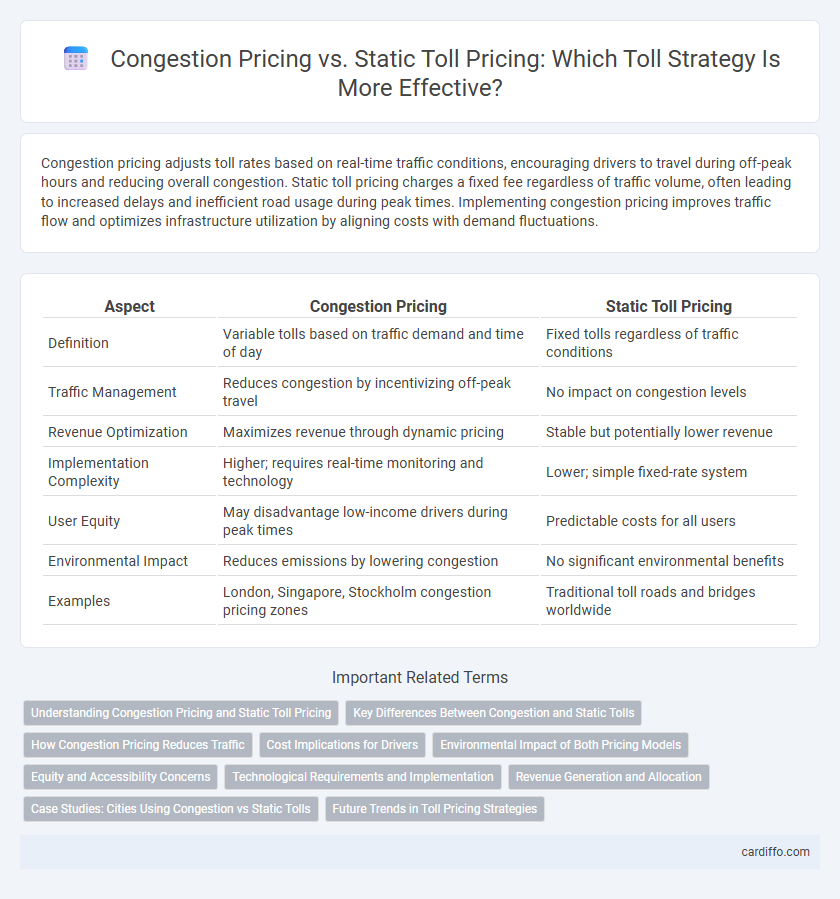Congestion pricing adjusts toll rates based on real-time traffic conditions, encouraging drivers to travel during off-peak hours and reducing overall congestion. Static toll pricing charges a fixed fee regardless of traffic volume, often leading to increased delays and inefficient road usage during peak times. Implementing congestion pricing improves traffic flow and optimizes infrastructure utilization by aligning costs with demand fluctuations.
Table of Comparison
| Aspect | Congestion Pricing | Static Toll Pricing |
|---|---|---|
| Definition | Variable tolls based on traffic demand and time of day | Fixed tolls regardless of traffic conditions |
| Traffic Management | Reduces congestion by incentivizing off-peak travel | No impact on congestion levels |
| Revenue Optimization | Maximizes revenue through dynamic pricing | Stable but potentially lower revenue |
| Implementation Complexity | Higher; requires real-time monitoring and technology | Lower; simple fixed-rate system |
| User Equity | May disadvantage low-income drivers during peak times | Predictable costs for all users |
| Environmental Impact | Reduces emissions by lowering congestion | No significant environmental benefits |
| Examples | London, Singapore, Stockholm congestion pricing zones | Traditional toll roads and bridges worldwide |
Understanding Congestion Pricing and Static Toll Pricing
Congestion pricing adjusts toll rates based on real-time traffic conditions to manage demand and reduce congestion, often leading to more efficient roadway usage. Static toll pricing imposes a fixed fee regardless of traffic levels, potentially resulting in underutilized roads during off-peak times and overcrowding during peak hours. Understanding these pricing models is essential for optimizing traffic flow and revenue generation on toll roads.
Key Differences Between Congestion and Static Tolls
Congestion pricing dynamically adjusts toll rates based on real-time traffic conditions to manage demand and reduce congestion, while static toll pricing charges a fixed fee regardless of traffic volume. Congestion tolls encourage off-peak travel by varying prices during high-traffic periods, improving road utilization and minimizing delays. Static tolls offer predictable costs but lack the flexibility to influence traffic patterns or alleviate congestion effectively.
How Congestion Pricing Reduces Traffic
Congestion pricing reduces traffic by dynamically adjusting toll rates based on real-time demand, encouraging drivers to travel during off-peak hours or use alternative routes. This variable pricing mechanism decreases road overcrowding, leading to smoother traffic flow and reduced travel times. By financially incentivizing behavior change, congestion pricing effectively lowers vehicle volume compared to static toll pricing, which charges a fixed rate regardless of congestion levels.
Cost Implications for Drivers
Congestion pricing dynamically adjusts toll rates based on traffic levels, leading to potentially higher costs during peak hours but savings during off-peak times, encouraging drivers to travel at less congested periods. Static toll pricing maintains a fixed rate regardless of traffic conditions, offering predictability but often resulting in higher expenses during rush hours when demand is greatest. Drivers may experience fluctuating costs with congestion pricing but can benefit from reduced overall travel expenses and less congestion-related delays compared to static toll systems.
Environmental Impact of Both Pricing Models
Congestion pricing reduces vehicle emissions by incentivizing off-peak travel and decreasing traffic density, leading to improved air quality and lower carbon footprints in urban areas. Static toll pricing often results in consistent traffic volumes regardless of time, causing prolonged periods of congestion and higher levels of pollutants like NOx and PM2.5. Implementing dynamic congestion pricing schemes aligns transportation costs with environmental goals by mitigating idling and stop-and-go traffic conditions that exacerbate environmental degradation.
Equity and Accessibility Concerns
Congestion pricing dynamically adjusts toll rates based on traffic levels, aiming to reduce congestion but raising equity concerns as low-income drivers may face higher costs during peak hours. Static toll pricing offers predictable costs regardless of traffic, enhancing accessibility for economically disadvantaged users but potentially failing to manage congestion effectively. Policymakers must balance affordability and access with traffic management to ensure equitable transportation systems.
Technological Requirements and Implementation
Congestion pricing systems require advanced real-time data collection technologies such as GPS, sensors, and dynamic pricing algorithms to adjust toll rates based on traffic flow and demand. Static toll pricing relies on simpler infrastructure, typically involving fixed toll booths or electronic toll collection without frequent rate changes, reducing implementation complexity. Implementing congestion pricing demands integration with traffic management platforms and continuous monitoring, whereas static tolls need basic electronic tolling equipment and less sophisticated software.
Revenue Generation and Allocation
Congestion pricing adapts toll rates based on real-time traffic conditions, optimizing revenue generation by charging higher fees during peak hours and reducing congestion-related costs. Static toll pricing maintains fixed fees regardless of traffic flow, potentially missing opportunities for increased revenue during high-demand periods. Allocating funds from congestion pricing often prioritizes infrastructure improvements and public transit enhancements to alleviate traffic, whereas static toll revenue typically supports general maintenance and operational expenses.
Case Studies: Cities Using Congestion vs Static Tolls
Singapore's Electronic Road Pricing system exemplifies dynamic congestion pricing by adjusting toll rates based on real-time traffic conditions, significantly reducing peak-hour congestion. In contrast, New York City's fixed toll pricing on bridges and tunnels maintains consistent fees regardless of traffic, leading to persistent congestion during rush hours. Stockholm's congestion tax combines elements of both, employing variable tolls during peak times that have successfully decreased inner-city traffic and improved air quality.
Future Trends in Toll Pricing Strategies
Future trends in toll pricing strategies emphasize dynamic congestion pricing, leveraging real-time traffic data and AI to optimize toll rates based on demand fluctuations, reducing congestion more effectively than static toll pricing. Advanced sensor networks and mobile applications enable personalized tolling, adjusting charges according to vehicle type, time of day, and traffic conditions to enhance traffic flow and revenue management. Integration with smart city infrastructure and autonomous vehicle systems further supports adaptive toll pricing, promoting sustainable urban mobility and reducing emissions.
Congestion pricing vs static toll pricing Infographic

 cardiffo.com
cardiffo.com